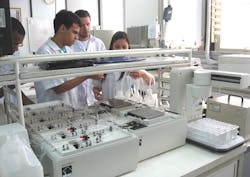It may not come as a surprise that the Middle East region accounts for almost half of the most water scarce countries in the world. Yet, what may come as more of shock is that certain areas of the US and China's Ningxia province could see water stress increase by up to 40 to 70% by 2040.
A new analysis from WRI ranks 167 countries for water stress in 2040, claiming that 14 of the 33 likely most stressed countries are in the Middle East. This includes nine considered extremely highly stressed with a score of 5.0 out of 5.0: Bahrain, Kuwait, Palestine, Qatar, United Arab Emirates, Israel, Saudi Arabia, Oman and Lebanon.
Using climate models and socioeconomic scenarios, WRI scored and ranked future water stress -- a measure of competition and depletion of surface water -- in 167 countries by 2020, 2030, and 2040.
It found that 33 countries face extremely high water stress in 2040 and that also Chile, Estonia, Namibia, and Botswana could face an especially significant increase in water stress by 2040.
According to WRI, drought and water shortages in Syria likely contributed to the unrest that stoked the country's 2011 civil war.
Dwindling water resources and chronic mismanagement forced 1.5 million people, primarily farmers and herders, to lose their livelihoods and leave their land, move to urban areas, and magnify Syria's general destabilisation. Meanwhile Saudi Arabia's government said its people will depend entirely on grain imports by 2016, a change from decades of growing all they need, due to fear of water-resource depletion.
While they will probably not face the extreme water stress blanketing the Middle East in 2040, global superpowers such as the US, China and India face water risks of their own. High water stress in all three countries are projected to remain roughly constant through 2040.
Every water-stressed country is affected by a different combination of factors. Chile, for example, projected to move from medium water stress in 2010 to extremely high stress in 2040. It is among the countries more likely to face a water supply decrease from the combined effects of rising temperatures in critical regions and shifting precipitation patterns. Meanwhile Botswana and Namibia sit squarely within a region that is already vulnerable to climate change.
Water supplies are limited and risk from floods and droughts is high. Futhermore, projected temperature increases in southern Africa are likely to exceed the global average, along with overall drying and increased rainfall variability. On the water demand side, according to Aqueduct projections, a 40 to 70% - or greater -- increase is expected.
Such situations severely threaten national water security and economic growth. As a result, WRI urged governments to respond with management and conservation practices that will help protect essential sustainable water resources for years to come.
************
Rio Lab Warns of Olympic Water Quality Danger
Scientists at the Federal University of Rio de Janeiro, who have been testing the waters around Rio for the last 20 years, have expressed disappointment with the lack of progress being made in preparation for the 2016 Olympics. The university's marine biology laboratory has revealed worrying trends for parameters such as ammonia, nitrates and phosphates.



